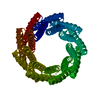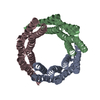+Search query
-Structure paper
| Title | Design of functionalised circular tandem repeat proteins with longer repeat topologies and enhanced subunit contact surfaces. |
|---|---|
| Journal, issue, pages | Commun Biol, Vol. 4, Issue 1, Page 1240, Year 2021 |
| Publish date | Oct 29, 2021 |
 Authors Authors | Jazmine P Hallinan / Lindsey A Doyle / Betty W Shen / Mesfin M Gewe / Brittany Takushi / Madison A Kennedy / Della Friend / James M Roberts / Philip Bradley / Barry L Stoddard /  |
| PubMed Abstract | Circular tandem repeat proteins ('cTRPs') are de novo designed protein scaffolds (in this and prior studies, based on antiparallel two-helix bundles) that contain repeated protein sequences and ...Circular tandem repeat proteins ('cTRPs') are de novo designed protein scaffolds (in this and prior studies, based on antiparallel two-helix bundles) that contain repeated protein sequences and structural motifs and form closed circular structures. They can display significant stability and solubility, a wide range of sizes, and are useful as protein display particles for biotechnology applications. However, cTRPs also demonstrate inefficient self-assembly from smaller subunits. In this study, we describe a new generation of cTRPs, with longer repeats and increased interaction surfaces, which enhanced the self-assembly of two significantly different sizes of homotrimeric constructs. Finally, we demonstrated functionalization of these constructs with (1) a hexameric array of peptide-binding SH2 domains, and (2) a trimeric array of anti-SARS CoV-2 VHH domains. The latter proved capable of sub-nanomolar binding affinities towards the viral receptor binding domain and potent viral neutralization function. |
 External links External links |  Commun Biol / Commun Biol /  PubMed:34716407 / PubMed:34716407 /  PubMed Central PubMed Central |
| Methods | EM (single particle) / X-ray diffraction |
| Resolution | 2.1 - 6.5 Å |
| Structure data | EMDB-24425, PDB-7rdr:  PDB-6xr1:  PDB-6xr2: |
| Chemicals |  ChemComp-HOH: |
| Source |
|
 Keywords Keywords | DE NOVO PROTEIN / Computationally designed / de novo / toroid / helix-turn-helix / PEPTIDE BINDING PROTEIN / protein display particles |
 Movie
Movie Controller
Controller Structure viewers
Structure viewers About Yorodumi Papers
About Yorodumi Papers





